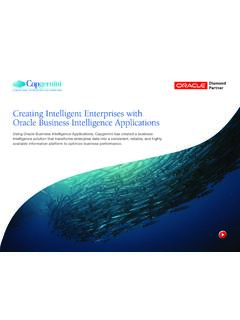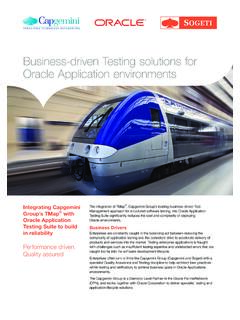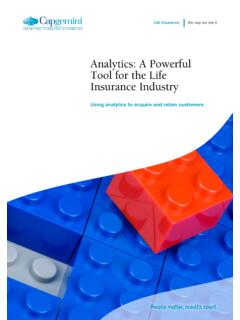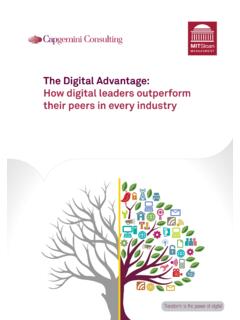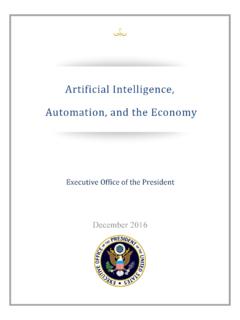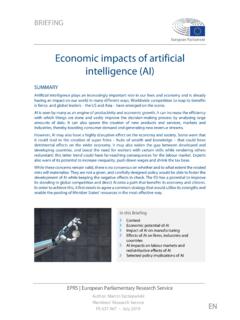Transcription of Accelerating automotive's AI
1 Accelerating automotive's AI transformation:How driving AI enterprise-wide can turbo-charge organizational valueArtificial intelligence (AI) holds the key to a new future of value for the automotive industry. While popular attention is focused on the use of AI in autonomous cars, the industry is also working on AI applications that extend far beyond engineering, production, supply chain, customer experience, and mobility services among others. Not only are AI technologies critical for enabling our autonomous vehicles, but they are playing an increasing role in transforming our customer and employee experiences , says Jeff Lemmer, vice president and CIO, Ford Motor Company. Supply chain risk identification, and in-vehicle predictive maintenance, are just a few of the ways Ford is already applying AI to improve our customer and business operations. Atif Rafiq, global chief information officer and chief digital officer, Volvo Car Group, echoes this sentiment, saying: Car companies are actively using AI in their autonomous driving efforts and this typically gets the most headlines.
2 But every facet of this industry can benefit, including how cars are made and sold and to invent new customer experiences. 1 There are many examples of AI s reach into the industry: General Motors "Dreamcatcher" system uses machine learning to transform prototyping. The solution was recently tested with the prototyping of a seatbelt bracket part, which resulted in a single-piece design that is 40% lighter and 20% stronger than the original eight-component Continental, one of the largest automotive parts suppliers, has developed an AI-based virtual simulation program. The program can generate 5,000 miles of vehicle test data per hour, when it currently takes over 20 days from physical Volkswagen built its own speech technology team at its DATA:LAB in Munich in 2017 to take over standardized communication with suppliers. The goal of the project was to support procurement processes for commodities and merchandise under $10,000. 4 koda is testing the use of autonomous drones for stocktaking at its factory in Mlad Boleslav, Czechia.
3 The technology detects, identifies and counts empty containers outside the factory from above, three times a day, and transmits the data it collects to koda s logistics department for IntroductionGiven the impact that AI is having, we have undertaken significant research into AI in the automotive industry. Building on a cross-sector study we conducted in 2017, we have recently surveyed 500 automotive executives across eight countries as well as conducted in-depth interviews with industry experts and entrepreneurs (see research methodology at the end of this report). This report focuses on incumbent players in the automotive industry and not on the new entrants such as research finds that the industry has made modest progress in AI-driven transformation since 2017. Many organizations have yet to scale their AI applications beyond pilots and proofs-of-concept. Yet, there is a group of companies that are making significant progress in driving use cases at scale.
4 Characteristics of this group of companies offer an insight into best practice in scaling this report we explore: Where the industry stands in scaling its AI implementations What concrete benefits can result from scaled initiatives Where automotive manufacturers should focus their AI investments Success factors and recommendations for scaling AI. 2 Accelerating Automotive s AI Transformation2 General Motors' use of AI has resulted in designing a seatbelt part which is 40% lighter and 20% stronger than the original number of automotive companies deploying AI at scale has increased only marginallyThe industry is making slow progress in taking AI from experimentation to enterprise scale. As Figure 1 shows, our research found that:Modest progress in scaling AI The share of automotive companies deploying AI at scale6 has grown marginally to 10% compared to 7% in 2017. The number of selective AI implementations (at multiple sites in an organization, but not at enterprise scale) has not moved significantly, standing at 24% today (January 2019) versus 2017 s 27%.
5 Figure 1: Number of automotive organizations implementing AI at scale has increased only marginallySource: Capgemini Research Institute, AI in Automotive Executive Survey, December 2018-January 2019, N=500 automotive implementation = ongoing implementation across all sites/enterprise wide with full scope and scale; Selective implementation = ongoing implementation at multiple sites in various parts of an organization, but not at an enterprise level; Pilots = initial roll out with limited scope at one site. "Now" refers to December 2018 January 2019, the period during which the survey was implementationNot implemented any AI initiativeSelective implementationPilots and POCsMid-2017 NowStatus of AI implementation at automotive organizations7%10%27%24%41%26%26%39%4 Accelerating Automotive s AI Transformation4 There are a number of factors that could be contributing to this performance: Roadblocks to technology transformation are still significant, such as legacy IT systems that do not talk to each other, question marks over availability and accuracy of data, and lack of skills7.
6 Organizations identify integration challenges with existing systems and tools (38%), lack of knowledge and awareness of next-gen AI tools (36%), and lack of training data (35%) as top technology challenges hindering scaling of AI. The hype and high expectations that initially came with AI may have turned into a more downbeat and pragmatic view as companies confronted the reality of implementation. Difficulty in proving the benefits and return on investment at pilot stage (45%) and difficulty in selecting the use cases to scale (43%) are biggest organizational hurdles. A significant development is in the number of organizations that said they are not implementing AI today (39% today versus 26% in 2017). This trend is more pronounced at smaller organizations 43% of organizations with less than $10 billion annual revenues are not implementing AI, but this drops to only 19% in organizations in the $10 billion to $20 billion bracket. The drop in the share of organizations experimenting with AI (41% to 26%) shows a clearer focus in selection and scaling of use cases.
7 It is also indicative of an uphill battle for organizations since AI, just like other digital technologies, has been more difficult for organizations to master than they initially perceived. Now, companies have developed their understanding of AI and where it can bring benefits, becoming more selective in terms of scaling AI is AI? artificial intelligence (AI) is a collective term for the capabilities shown by learning systems that are perceived by humans as representing intelligence . Today, typical AI capabilities include speech, image and video recognition, autonomous objects, natural language processing, conversational agents, prescriptive modeling, augmented creativity, smart automation, advanced simulation, as well as complex analytics and share of automotive organizations deploying AI at scale has grown to 10% compared to 7% in 2017. 55 OEMs are more advanced than their supplier and dealer counterpartsOur research shows that OEMs are making better progress than their supply chain peers including parts suppliers and US, UK, and German automotive companies lead in implementing AI at scale The US leads the way in terms of progress, with 25% of companies implementing AI at scale and 25% at a selective level (see Figure 3).
8 The UK and Germany follow America s lead, but China has also nearly doubled its share of scaled AI implementations (from 5% to 9%). This increase in China is the most pronounced growth trend across all Kai-Fu Lee, chairman and CEO of Sinovation Ventures and former president at Google China alludes to this emerging Chinese capability in his recently published book, AI Superpowers: China, Silicon Valley, and the New World Order. In a recent interview with us, Dr. Kai-Fu Lee says, dealers in scaled AI deployments. We found that 43% of OEMs are implementing AI at scale or selectively, compared to 25% of suppliers and 16% of dealers (see Figure 2). I think China will be as strong as the US .. the two worlds exist in parallel universes. It s not very easy to cross but, at the same time, there are many very clever uses of AI in China that could be inspirational for American organizations. 8To accelerate AI innovation, China s automotive and mobility technology companies are following an open platform approach.
9 This is in contrast to other automotive players, who are focused on keeping their platforms proprietary. For example, Baidu, a technology company and a leading self-driving player in China, launched Apollo, an open-source autonomous driving platform, which partnered with over 130 OEMs, suppliers and chipmakers in less than two Similarly, China's leading electric OEM, BYD, opened access to data and controls of its vehicles for third-party developers, Figure 2: AI implementation in the automotive industry by industry segmentSource: Capgemini Research Institute, AI in Automotive Executive Survey, December 2018 January 2019, N=500 automotive of AI implementation as defined in the research: Scaled implementation = ongoing implementation across all sites/enterprise wide with full scope and scale; Selective implementation = ongoing implementation at multiple sites in various parts of an organization, but not at an enterprise level."Now" refers to December 2018 January 2019, the period during which the survey was implementationScaled implementationEvolution of AI implementation at automotive organizations - by industry segmentsOEMS upplierDealerMid-2017 NowMid-2017 NowMid-2017 Now10%29%14%29%27%4%4%21%16%3%12%4%6 Accelerating Automotive s AI TransformationFigure 3: Status and evolution of AI implementation in the automotive industry by countrySource: Capgemini Research Institute, AI in Automotive Executive Survey, December 2018 January 2019, N=500 automotive implementation = ongoing implementation across all sites/enterprise wide with full scope and scale; Selective implementation = ongoing implementation at multiple sites in various parts of an organization, but not at an enterprise level; Pilots = initial roll out with limited scope at one site.
10 "Now" refers to December 2018 January 2019, the period during which the survey was the first OEM to do In addition, the country has been home to pioneering innovations in mobility services. For example, ride-hailing service Didi Chuxing offers its customers an augmented reality (AR) indoor navigation service that allows customers at airports, train stations, and malls to easily reach a vehicle pick-up location. It leverages computer vision positioning and 3D scene reconstruction technologies to enable the implementationScaled implementationPilots and POCsNot implemented any AI initiativeState of AI Implementation at automotive organizations - by country13%36%25%25%US12%34%39%14%UK32%30 %25%12%Germany13%42%35%10%Sweden44%17%31 %9%China49%26%18%8%France54%20%21%5%Ital y67%17%14%2%IndiaNowMid-201718%25%9%14%1 1%8%5%6%3%5%2%2%8%9%12%10%Evolution of scaled AI deployments in automotive organizations - by countryUSGermanyUKSwedenChinaFranceItaly India7 Few functions have implemented AI at scaleScaled implementation in different functions from mobility services to R&D is relatively rare, as Figure 4 shows.
